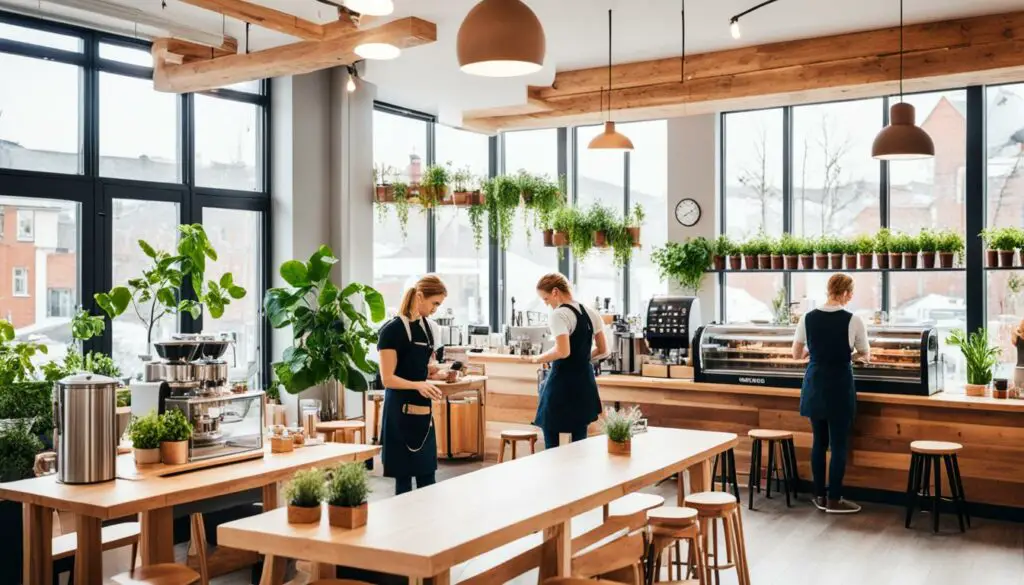Are you a coffee lover who relies on Nespresso pods for your caffeine fix? Have you ever wondered how much caffeine is actually in one Nespresso pod, or if there are options for decaf capsules? With the popularity of these coffee pods, it’s important to understand the exact caffeine intake when consuming them. For those looking for a milder option, the half caffeinato pod may be a good choice, providing about half the caffeine of an average cup. So whether you prefer a strong drink or a milder one, it’s important to know your options when it comes to Nespresso pods.
But first, let’s take a brief look at the history of Nespresso pods and their widespread use in coffee machines. These small capsules are filled with ground coffee beans that are specifically designed to be used with a Nespresso coffee maker. While some people prefer the taste of regular coffee, the convenience and consistency of using pods has made them a popular choice for many coffee lovers.
As we delve into the importance of caffeine content in coffee and its effects on our bodies, we’ll also touch on the controversy surrounding Nespresso pod recycling. So grab an espresso shot or a cup of original Nespresso coffee as we discover just how much caffeine is in each pod. For those looking for a lower caffeine option, we also have decaf pods available. And if you’re a fan of the Vertuo line, don’t worry – we’ll be discussing the caffeine content of those capsules too. Plus, with the added energy boost from caffeine, Nespresso is the perfect pick-me-up for any time of day.
Nespresso Pod Caffeine Content Chart/Ranking
Comparison of Caffeine Content in Different Types of Nespresso Pods
Nespresso coffee capsules are a convenient way to enjoy a delicious cup of coffee with minimal effort. However, if you’re looking for information on which variety of capsules have the highest caffeine content, it’s important to know that the amount of caffeine in each capsule varies depending on the type and intensity level. Robusta capsules may offer a higher caffeine boost than other varieties.
Ranking List from Highest to Lowest Caffeine Content
Here is a list of Nespresso pods ranked from highest to lowest caffeine content, perfect for those who prefer a quick and convenient alternative to brewing regular coffee with a coffee machine. These pods are made with high-quality coffee beans, including robusta coffee, to ensure a rich and flavorful cup every time.
- Kazaar: 125 mg
- Dharkan: 120 mg
- Ristretto: 80 mg
- Arpeggio: 70 mg
- Roma: 60 mg
- Livanto: 50 mg
- Volluto: 50 mg
- Capriccio: 50 mg
It’s worth noting that the Nespresso coffee capsules, both OriginalLine and VertuoLine, have different caffeine content. The VertuoLine Nespresso capsules have higher caffeine content due to their larger size, making them perfect for those who prefer a double espresso or an extra strong espresso shot.
Explanation of How Caffeine is Measured in Coffee
Caffeine levels are measured in milligrams (mg) per serving size, which can vary depending on how much coffee is used per pod or cup. Nespresso capsules and double espresso pods have different serving sizes, so the caffeine content may vary. An espresso shot typically contains around 63mg of caffeine, while Nespresso Vertuo pods are known to have higher caffeine levels.
- NESPRESSO VERTUOLINE VARIETY PACK ASSORTMENT: This Nespresso coffee assortment offers 30 Nespresso Pods in a variety of 3 best-selling coffee blends for the Nespresso VertuoLine System.10 Stormio, 10 Odacio, 10 Melozio
Prices pulled from the Amazon Product Advertising API on:
Product prices and availability are accurate as of the date/time indicated and are subject to change. Any price and availability information displayed on [relevant Amazon Site(s), as applicable] at the time of purchase will apply to the purchase of this product.
Comparison with Other Popular Coffee Drinks
If you’re in need of a caffeine fix, you may be wondering how Nespresso coffee compares with other popular coffee drinks in terms of caffeine levels. While it depends on the specific variety, Nespresso coffee generally contains about as much caffeine as a standard cup of coffee. However, if you’re looking for an extra boost, you may want to try the Vertuo pods, which have higher caffeine levels.
- One shot of espresso typically contains around 63mg of caffeine. If you prefer using Nespresso coffee capsules, original Nespresso coffee, or Nespresso coffee pods, the caffeine content may vary.
- A standard cup (8 oz) of brewed coffee has between 70-140mg of caffeine, depending on the type and brewing method. However, if you prefer a stronger and more intense caffeine kick, you may want to try double espresso pods from original Nespresso capsules. These pods have a higher intensity and are perfect for those who need an extra boost of energy.
- The original Nespresso coffee capsules come in different intensities. A grande-sized Starbucks latte (16 oz) contains about 150mg of caffeine, which is more than what you would find in most Nespresso coffee pods.
So while some Nespresso capsules may contain less caffeine than other types of coffee drinks, they still provide a decent amount of mg for those who want a quick pick-me-up without having to brew a full pot of coffee. The intensity of the Vertuo capsules can also be adjusted to suit your taste preferences.
Potential Health Concerns of Consuming High-Caffeine Nespresso Pods
Recommended Daily Caffeine Intake
Caffeine is a natural stimulant found in coffee, tea, and some soft drinks. The recommended daily caffeine intake for adults is 400mg or less per day, which equates to approximately four cups of coffee or espresso. However, this limit may vary depending on individual factors such as age, weight, and health conditions. The intensity of caffeine in espresso capsules can vary greatly, so it’s important to check the label before consuming.
Possible Side Effects and Health Risks Associated with High Caffeine Consumption
Consuming high amounts of nespresso coffee, especially through coffee pods and capsules, can lead to several side effects such as headaches, jitteriness, anxiety, and insomnia. In extreme cases, it can also cause irregular heartbeat and high blood pressure. Excessive caffeine consumption, with some nespresso coffee pods containing up to 19 mg of caffeine per pod, can cause dehydration due to its diuretic effect.
Explanation on How Individual Tolerance Levels Can Affect Health Concerns
Individual tolerance levels for caffeine vary significantly among people due to differences in genetics and lifestyle factors. Some individuals may experience adverse effects even at low doses of caffeine while others may tolerate high amounts without any issues. It’s essential to understand your body’s response to caffeine before consuming high-caffeine capsules like Nespresso pods, which contain up to 10 mg of caffeine per capsule.
Importance of Moderation When Consuming High Caffeine Products
If you enjoy the taste of Nespresso capsules but are concerned about their high caffeine content, there are decaf options available that provide the same flavor without the jolt of energy. Alternatively, you could opt for Nespresso capsules with lower intensity levels that contain less caffeine than their stronger counterparts, typically ranging from 55-65 mg per capsule.
Coffee Bean Types and Their Impact on Nespresso Caffeine
Overview of Different Types of Coffee Beans Used in Nespresso Pods
Nespresso pods are made from various coffee beans, each with its unique characteristics. The two primary types of coffee beans used in Nespresso pods are arabica and robusta, which differ in their caffeine levels. If you need a quick caffeine fix, Nespresso capsules contain much caffeine to give you that energy boost.
Arabica beans are known for their delicate flavor, low acidity, and lower caffeine content compared to robusta beans. Robusta beans have a higher caffeine content and a stronger, bitter taste that is often described as earthy or woody. For those who prefer a more convenient way of enjoying coffee, coffee pods or capsules are available in various sizes containing different amounts of mg of coffee. Espresso lovers can now enjoy the rich taste of Arabica or Robusta coffee in a quick and easy way using these coffee pods or capsules.
Nespresso also offers decaf capsules for those who want the taste of coffee without the caffeine buzz. Decaf beans undergo a process that removes most of the caffeine while preserving the flavor profile, with each capsule containing less than 1 mg of caffeine.
Explanation on How Roasting Affects Caffeine Content
Roasting is a crucial step in determining the final flavor profile of coffee capsules. However, roasting also affects the caffeine content of the coffee bean, which can vary from 1 to 2 mg per capsule.
Lighter roasts tend to have higher caffeine content than darker roasts since more heat destroys some caffeine molecules during longer roasting times. Therefore, if you’re looking for a high-caffeine Nespresso capsule with around 60-80 mg of caffeine, opt for lighter roast options like Livanto or Volluto.
Discussion on the Impact of Origin and Processing Methods on Caffeine Levels
The origin and processing methods can also impact the caffeine levels in Nespresso capsules. For instance, coffee grown at higher altitudes tends to have lower caffeine content but more complex flavors due to slower growth rates. It is important to note that each capsule contains an average of 5 mg of caffeine.
Washed processing methods typically result in higher caffeine extraction than natural processing methods because it removes more layers from the bean before drying them out. This results in less interference during brewing which leads to increased extraction efficiency, especially when using capsules. The amount of caffeine extracted can vary, but on average, a capsule contains around 80-100 mg of caffeine.
Mentioning Any Unique Characteristics or Flavors Associated with Specific Bean Types
Each type of bean has its unique characteristics that contribute to its overall flavor profile when brewed into espresso shots using Nespresso machines and capsules, providing the perfect caffeine fix with a precise amount of mg per serving.
Factors Affecting Nespresso Pod Caffeine Content
Description of Factors Influencing Nespresso Pod Caffeine Content
The amount of caffeine in a single Nespresso pod can vary depending on several factors, with the most significant being brewing time. The longer the brewing time, the more caffeine is extracted from the coffee grounds, resulting in a stronger cup of coffee with higher mg content.
Water temperature also plays a crucial role in determining caffeine content, measured in mg. Hotter water extracts more caffeine than cooler water, so adjusting your machine’s temperature setting can have a significant impact on your coffee’s strength and the amount of caffeine it contains.
Pressure is another factor that affects caffeine extraction. Higher pressure results in more efficient extraction and higher caffeine content in terms of mg.
Effect on Taste and Strength
While these factors affect caffeine content, they also influence taste and strength in terms of milligrams (mg). Longer brewing times result in stronger coffee but may lead to bitterness or over-extraction if not done correctly, affecting the overall mg of the coffee.
Higher temperatures can produce a richer flavor profile but may also result in burnt or bitter notes if too high. Additionally, it is important to note the nespresso caffeine content, which can vary from 55 mg to 85 mg depending on the capsule.
Adjusting pressure settings can enhance crema production and improve mouthfeel, but it can also cause over-extraction or under-extraction if not calibrated correctly. It’s important to note that the Nespresso caffeine content may vary and is typically around 5 mg per serving.
Adjusting Machine Settings for Optimal Results
To achieve optimal results, adjust your machine settings based on your preference in mg. For example:
- Shorter brew times: For those who prefer milder coffee with less caffeine in milligrams.
- Lower water temperatures: For those who want to avoid burnt or bitter notes and reduce the amount of dissolved minerals in their water by a few mg.
- Lower pressure settings: Ideal for those who prefer a milder mg sensation without compromising flavor intensity.
Experiment with different combinations until you find the perfect balance between taste and strength that suits your palate, measured in mg.
Tips for Consistent Results
To ensure consistent results every time you brew your Nespresso pods, check the mg content of your pod.
- Clean your machine regularly to prevent any buildup in mg that could affect extraction efficiency.
- Use fresh water every time to avoid any residual flavors from previous brews. Adding a few mg of minerals can enhance the taste.
- Store your pods in a cool, dry place away from direct sunlight to maintain freshness.
Recycling Nespresso Pods and Making Iced Coffee with Them
Different ways to recycle used nespresso pods including upcycling ideas.
Nespresso machines have become a staple in many households, but with the convenience of single-serve coffee comes the environmental impact of disposing of those little pods. Fortunately, there are several ways to recycle used Nespresso pods and reduce waste.
One option is to simply recycle the pods through Nespresso’s recycling program. You can request a free recycling bag from Nespresso, fill it with your used pods, and drop it off at a collection point or schedule a pick-up. The aluminum from the pods is recycled into new products such as bicycles and car parts.
If you’re feeling crafty, you can also upcycle your used Nespresso pods into art projects or decorations. There are many creative ideas online for turning these tiny metal cups into everything from Christmas ornaments to jewelry.
The environmental benefits associated with recycling nespresso pods.
Recycling Nespresso pods has numerous environmental benefits. By keeping the aluminum out of landfills, we reduce greenhouse gas emissions that come from producing new aluminum products. Recycling saves energy because it takes less energy to melt down existing aluminum than it does to mine and refine bauxite ore for new aluminum.
Another benefit of recycling Nespresso pods is that it reduces water usage. Aluminum production requires large amounts of water, so by recycling the metal from used pods instead of mining new ore, we conserve water resources.
How to make iced coffee using recycled nespresso pods.
Making iced coffee using recycled Nespresso pods is easy and delicious! Here’s how:
- Brew a shot (or two) of espresso using your Nespresso machine.
- Pour the hot espresso over ice in a tall glass.
- Add milk or creamer if desired.
- Sweeten with sugar or syrup if desired.
- Stir and enjoy!
Recipe ideas for making flavored iced coffees.
Final Thoughts on Nespresso Pod Caffeine Content
After analyzing the Nespresso pod caffeine content chart and ranking, it is clear that the amount of caffeine in one Nespresso pod varies depending on several factors. The potential health concerns of consuming high-caffeine Nespresso pods should be taken into consideration, especially for those with sensitivity to caffeine.
The type of coffee beans used in Nespresso pods can also affect their caffeine content. Factors such as cup size, water temperature, and brewing time can impact the amount of caffeine in your cup.
It’s important to note that recycling Nespresso pods and making iced coffee with them is a great way to reduce waste and enjoy a refreshing beverage. However, it’s crucial to dispose of the pods properly and follow recycling guidelines.
In conclusion,There isn’t a straightforward answer. It depends on various factors that can affect the final result. As a consumer, it’s essential to understand these variables and make informed decisions about your coffee consumption.
FAQs
Q: Are there decaf options available for Nespresso pods?
A: Yes, there are decaf options available for those who want to enjoy the taste of coffee without the added caffeine.
Q: Can I reuse a Nespresso pod more than once?
A: While it’s possible to reuse a pod more than once, the quality of your coffee may be compromised. It’s best to use each pod only once for optimal flavor.
Q: Is it safe to consume high-caffeine Nespresso pods regularly?
A: Consuming high amounts of caffeine regularly can lead to negative health effects such as anxiety or insomnia. It’s important to monitor your intake and consider switching to lower-caffeine options if necessary.
Q: How do I recycle my used Nespresso pods?
A: Most areas have specific recycling guidelines for Nespresso pods. Check with your local waste management facility or visit Nespresso’s website for more information.
Q: Can I make iced coffee using a Nespresso pod?
A: Yes, you can make iced coffee using a Nespresso pod. Brew the coffee over ice and add milk or sweetener as desired for a refreshing summer beverage.















